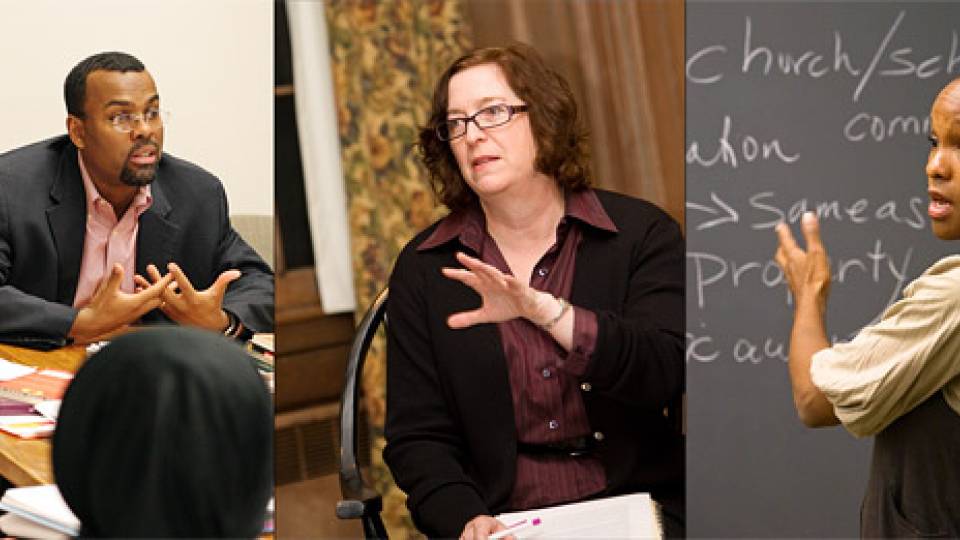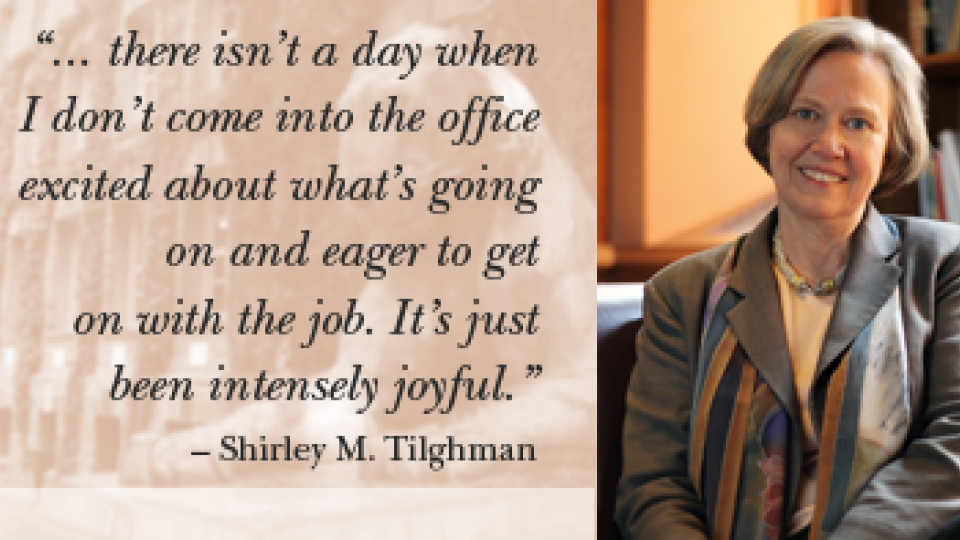From the April 10, 2006, Princeton Weekly Bulletin(Link is external)
In 1969 following a student strike at San Francisco State College, the first black studies program was created at an American institution. Over the next four years, hundreds of such programs popped up at universities across the country.
The story of black studies and its roots in the turbulent 1960s may seem one of the “establishment” bowing to demands of militant black protesters. But there’s a broader account — involving the key role white philanthropy played in creating these programs — revealed in a new book by Princeton’s Noliwe Rooks.
Rooks, associate director of the University’s Program in African American Studies(Link is external) and lecturer in history, has written “White Money/Black Power: The Surprising History of African American Studies and the Crisis of Race in Higher Education” (Beacon Press). She demonstrates that the Ford Foundation, under the leadership of McGeorge Bundy, saw its grants to these programs as a way to desegregate and integrate the student bodies, faculty and curricula at America’s universities.
“The success of the Ford Foundation’s strategy of funding black studies programs has created a complex situation wherein institutions continue to use the field in order to diversify their institutions, but very often, the preponderance of black people in and around African American studies programs, and their absence in other departments in those institutions, unfairly mark the field as an affirmative action program,” she writes. “While individual faculty members within African American studies may be viewed as intelligent, the field — usually structured as an interdisciplinary entity where faculty hold appointments in both traditional departments and with African American studies — is rarely viewed as the vibrant site of intellectual activity that it is.”
“Those early strategies around institutionalizing black studies,” she adds “… currently threaten the very viability of African American studies and have implications for how we think about, discuss and understand both affirmative action and racial integration within colleges and universities today.”
Rooks further points out that the movement that demanded the creation of black studies programs was, at most institutions, not solely an effort by African Americans but a multiracial call for change.
“However, black studies is rarely viewed as a successful example of social justice, a means of multiracial democratic reform, or a harbinger of widespread institutional and cultural change in relation to race, integration and desegregation at the postsecondary level,” she writes. “That is precisely what these programs were, and what they tell us today about the role and meaning of race in higher education … is no less instructive than it was 30 years ago. …”
Rooks recently spoke about the book and the ramifications of her findings for the future of black studies.
Why did the Ford Foundation become such a big supporter of black studies programs. What was the agenda?
It was really a sort of perfect storm of events. McGeorge Bundy was stepping down as national security adviser. He had served in both the Kennedy and Johnson administrations, and had taken over as head of Ford [in 1966]. The moment he starts to pay attention [to domestic affairs] is when America is really convulsive around this issue of race. There are urban uprisings in cities across America, black communities are fighting with police, black power is becoming more pronounced.
He said that America had a longstanding “negro problem,” which was his term for it. And he decided to dedicate his tenure at the Ford Foundation to addressing the negro problem (and public broadcasting). This is at the same time that students on campuses are starting to call for black studies. So he saw it as a way of addressing a larger issue that America had around race and racial equality.
You talk in the book about there being another agenda in relation
to black separatists. So do you think that by Ford stepping in with this
funding, the other agenda was put aside?
Initially, McGeorge Bundy was not opposed to black power or ideas of black separatism. He made statements about how black students and black leaders were justifiably angry and talked about how black power seemed to him to be a reasonable response to the issues. Black power, some argue in black communities, was all about black separatism — about undoing the history of integration that the country was making an effort to achieve at an educational level. So if you started to fund black studies departments as a separate entity, you were undermining this whole idea of integration. He initially didn’t believe that this was the case. He believed that it made some sense to have black people and black studies be separate so that from a position of power they could begin to integrate into the country.
As time went on, he ran into problems. People saw him as siding with black power and separatist groups, and the outcry reached the White House and Congress. By the time [the Ford Foundation] actually got around to deciding how they wanted to fund the institutionalized black studies programs, they gave any hint of separatism or militancy a wide berth. They decided to come up with a rationale that was really about heightening racial education for white students, not having black communities be so much involved in what was going on. There was a great sense of ownership initially from black communities about who was being hired and what was being taught. It was seen as a victory for the black freedom struggle.
Bundy went in another direction and said [that the programs would be] about desegregating faculty, curricula and student bodies as opposed to empowering communities that would be tied to a particular viewpoint.
What do you think black studies programs would have been like without the funding from the Ford Foundation?
So many programs were being started all over the country. Within one year, from the first program at San Francisco State in 1969, there were over 500 popping up all over the place. Then if you add in community colleges and high schools, which also had started black studies programs, it was over 1,000.
So the issue for Ford was that they looked at these programs and talked to people who were involved with them, and they just didn’t seem to be evolving in any unified way. It just seemed to be whatever anyone thought was needed wherever they were across the country. Bundy and other program officers understood that this wasn’t going to be sustainable — all of the good that they believed black studies could do was not going to be possible because no one was going to have money to sustain this hodgepodge. They wanted to offer a coherent and unified plan. If Brown v. the Board of Education in 1954 said to put an end to separate but equal education in this country, [they felt they needed] to look at how that could play out in higher education.
What some people were arguing for instead of funding for programs was funding for time and space to get together and think about what made the most sense. Who was going to teach the curriculum — what kind of faculty? They wanted to take a couple of years and talk about how something that was so new, that clearly had such possibilities, could best be implemented. If the Ford Foundation hadn’t come in, you would have had a variety of uses and understandings of black studies that would have reflected whatever students and community groups at institutions felt would most benefit them at the time. And there would have been more of a dialogue, more hashing out what it could be used for and look like.
Do you think black studies programs currently are at a crossroads? What is their status on campuses today?
As I was doing this project, it really struck me that we are at a time as we’re approaching the 40th anniversary of black studies where we need to look back and figure out where it is as a field going. At the same time that you see programs at Harvard, Duke and Northwestern take flight and become departments and have faculty coming up with fascinating curricula, you see the programs in a lot of state schools really struggling, folding, being gutted. There are programs at elite institutions that have turned the corner, but when you look around as a whole, that unevenness is a concern.
Another concern is that in the middle of the 1980s, administrators started to talk about black studies programs in language reminiscent of affirmative action programs. They may have thought it before, but they started to explicitly say this is a vehicle for recruiting a diverse faculty and students and making sure curricula become more diverse. One of the things that oftentimes happens with black studies is that it’s hard for people to see it as something other than addressing a social problem — something central to intellectual work around the country.
Where do we go from here? Do you have any ideas about what needs to be done?
One of the things is that black studies has always had the capability to help address pressing social issues. As we work toward resolving these issues internal to the field, I think one of the ways that we go from here is to desegregate the scholarship. If people see something is about a black topic, they think it won’t be relevant to them. The work that’s come out of black studies should not be as intellectually segregated as it is. It’s really central to so much that’s shared understanding about who we are and where we need to go. As black studies moves forward, we need to claim some of that passion and desire to address the meaning of America, the meaning of democracy, the meaning of citizenship, in a more coherent fashion — in the ways that in the 1960s the students wanted.
It’s so often the case these days that if you are black, it’s assumed that the work that you do is going to be about identity politics. That’s no longer the case. There’s a role for black studies to continue to play in these institutions of higher education around continuing the first-rate intellectual work that it’s doing but also helping us to see and understand America a little more fully — understanding some of the underlying structures that lead to social injustice. Black studies has some language for understanding the move from a pre-civil rights to a post-civil rights society, helping us understand a society and a culture that is becoming more diverse.
What has been the reaction since your book was published?
“What can we do?” has become a constant refrain. People understand that change needs to come from solidarity, from a collective sense of mission. They want to know, “How do we start to address it?”





